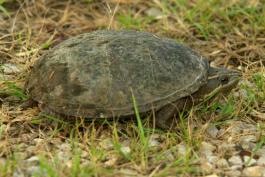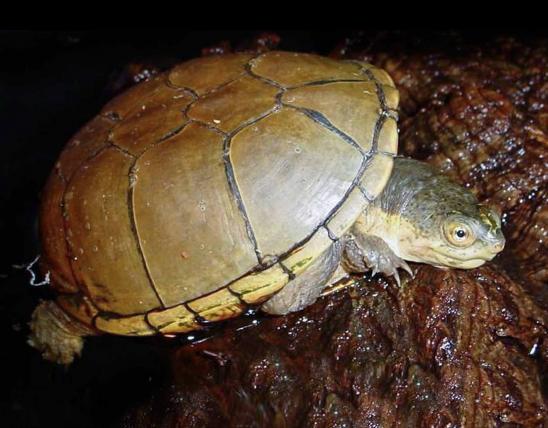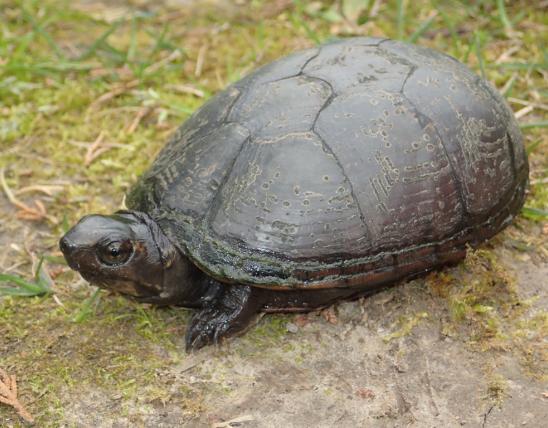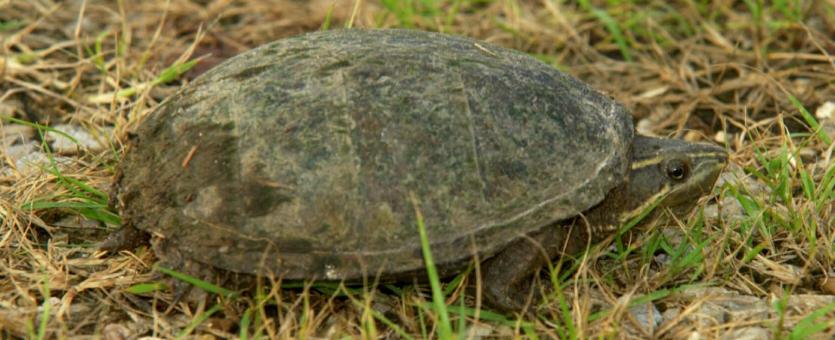
The eastern musk turtle, nicknamed the stinkpot, is a very small, dark turtle with a smooth, domed upper shell and reduced lower shell. The carapace (upper shell) is dark gray brown to black. The plastron (lower shell) is much smaller than the carapace; it is usually yellow, brown, or grayish yellow, and the forward part is movable (the hind portion, however, is not movable). The fleshy parts of the body are dark gray or black. There are normally 2 distinct yellow stripes along each side of the head and neck. Barbels (small projections of the skin) are present on the chin and throat.
This is Missouri's smallest species of turtle; most adults only reach about 4½ inches in upper shell length.
The nickname “stinkpot” refers to the odor given off by this species when captured. The odor is produced by musk glands in the skin just below the upper shell along the sides.
Similar species: Missouri has two other members of the Kinosternidae (mud and musk turtle family); both are in a different genus, Kinosternon (mud turtles), and both have different ranges in Missouri. Compared to the eastern musk turtle, the mud turtles have larger plastrons (lower shells), and both the front and hind parts are both movable:
- The yellow mud turtle (K. flavescens flavescens) is restricted to a few southwestern corner, some locations in west-central Missouri (the Kansas City area), and a few marshes in far northeastern Missouri.
- The Mississippi mud turtle (K. subrubrum hippocrepis) is found only in the Bootheel and some counties along the Arkansas border in southeastern Missouri.
Adult upper shell length: 2 to 4½ inches; occasionally to 6 inches. This is Missouri’s smallest turtle species and one of the world’s smallest turtles.
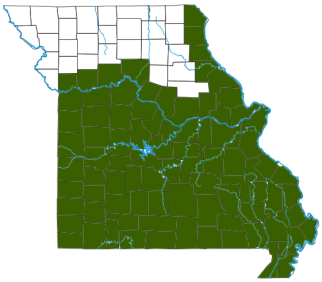
Occurs nearly statewide except for the northern third of the state. Some populations have been recorded in far northeastern counties, and they are expected to occur in Missouri counties along the Mississippi River; otherwise they are mostly restricted to counties along and south of the Missouri River.
Habitat and Conservation
In Missouri, this mostly aquatic species is most abundant in slow-current sections of rivers and larger streams of the Ozarks; the swamps, sloughs, and small ditches of the Bootheel; and in a few rivers in the northeastern part of the state. They can also occur in reservoirs. In their preferred habitats, they can be quite abundant.
During the active season, between March and November, eastern musk turtles spend most of their daylight hours buried in mud or resting on the bottom. They prefer to crawl along the bottom in shallow water and seldom leave the wetland. In the Bootheel, they show a preference for murky, shallow water.
Although they are rarely seen basking, they occasionally can be observed on logs, rocks, or small, horizontal tree trunks. For example, you might see them basking on logs and limbs of small, woody saplings or bushes along Ozark streams.
Eastern musk turtles overwinter in mud, usually at a depth of about 12 inches, at the bottom of a wetland.
Food
Eastern musk turtles are active bottom foragers searching for a wide variety of food, including aquatic insects, earthworms, crayfish, mollusks, small fish, tadpoles, algae, plants and their seed, and dead animals. The most frequently eaten items in a Missouri study were insects, mollusks, and plant seeds.
Status
Taxonomy: In addition to applying precise scientific names in Latin, herpetologists apply formal common names to amphibians and reptiles. This species used to be officially named the common musk turtle and the stinkpot.
Life Cycle
Eastern musk turtles are active from March to November. Courtship and mating occur in spring and fall, apparently peaking between April and the end of June.
In Missouri, most egg-laying likely occurs in May through July. As with many other turtles, members of this species may dig a nest hole and cover the eggs with soil; but some musk turtles may lay their eggs on open ground or under debris such as leaves, plants, rotting logs, or piles of sawdust. Occasionally, several females will share the same nesting sites, with many of the eggs intermingled.
Females lay 2–5 eggs, which hatch 65–86 days later (mostly in August and September). Upon hatching, young turtles are less than an inch in upper shell length.
Individuals reach maturity between 4 and 8 years of age; lifespan apparently can be 20–30 years.
Human Connections
Anglers occasionally catch eastern musk turtles on hook-and-line when using minnows, worms, or small crayfish for bait.
The neck is surprisingly long, and the head can reach back as far as the hind legs; to avoid a bite, keep this in mind if handling this species.
This species' Latin species name and common names all refer to the unpleasant, musky odor it emits in defense.
Ecosystem Connections
This turtle eats a variety of aquatic animals, helping keep those populations in check. Meanwhile, a variety of larger predators prey on the musk turtle. Its rather small lower shell affords little protection from predators. No doubt the musky odor it emits when captured serves as an extra defense, as does the habit of spending large amounts of time buried in the bottom mud of wetlands.
As with many animals, the eggs and young are most vulnerable. Egg predation can be especially heavy, as it is in many kinds of turtles.
This is one of the many species whose existence is secured when people conserve and protect healthy native wetland habitats.

